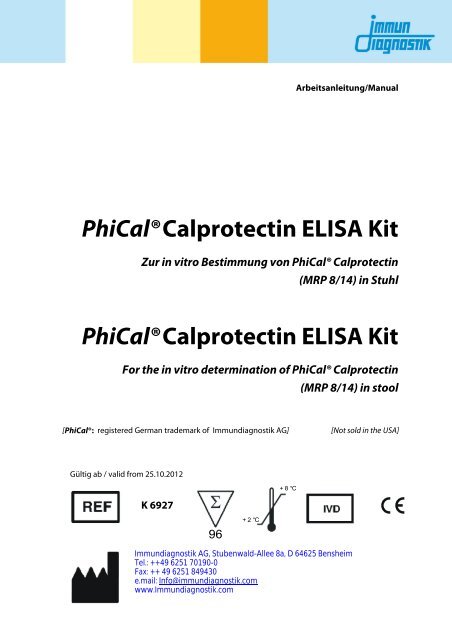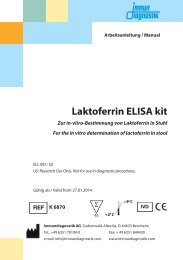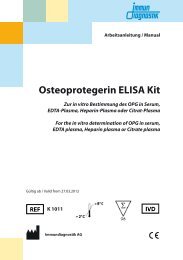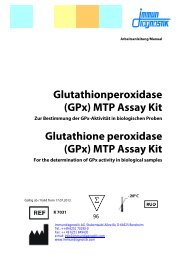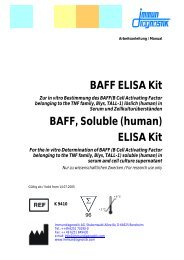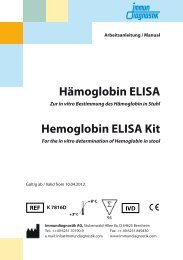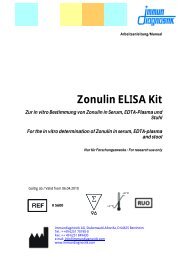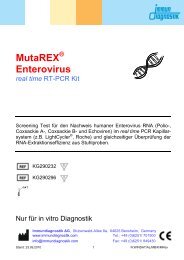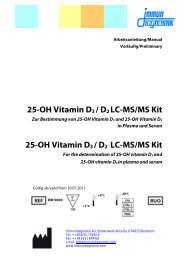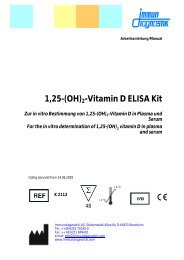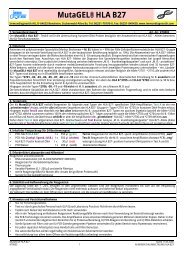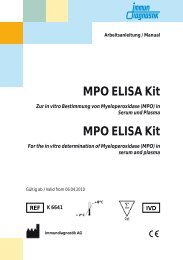Arbeitsanleitung/Manual PhiCal®Calprotectin - bei Immundiagnostik
Arbeitsanleitung/Manual PhiCal®Calprotectin - bei Immundiagnostik
Arbeitsanleitung/Manual PhiCal®Calprotectin - bei Immundiagnostik
Erfolgreiche ePaper selbst erstellen
Machen Sie aus Ihren PDF Publikationen ein blätterbares Flipbook mit unserer einzigartigen Google optimierten e-Paper Software.
96<br />
+2 °C<br />
+8 °C<br />
<strong>Ar<strong>bei</strong>tsanleitung</strong>/<strong>Manual</strong><br />
PhiCal® Calprotectin ELISA Kit<br />
Zur in vitro Bestimmung von PhiCal® Calprotectin<br />
(MRP 8/14) in Stuhl<br />
PhiCal® Calprotectin ELISA Kit<br />
For the in vitro determination of PhiCal® Calprotectin<br />
(MRP 8/14) in stool<br />
[PhiCal®: registered German trademark of <strong>Immundiagnostik</strong> AG] [Not sold in the USA]<br />
Gültig ab / valid from 25.10.2012<br />
K 6927<br />
<strong>Immundiagnostik</strong> AG, Stubenwald-Allee 8a, D 64625 Bensheim<br />
Tel.: ++49 6251 70190-0<br />
Fax: ++ 49 6251 849430<br />
e.mail: Info@immundiagnostik.com<br />
www.<strong>Immundiagnostik</strong>.com
<strong>Ar<strong>bei</strong>tsanleitung</strong>/<strong>Manual</strong> PhiCal® Calprotectin (MRP8/14)<br />
Inhaltsverzeichnis/Content Seite/Page<br />
1. VERWENDUNGSZWECK 4<br />
2. EINLEITUNG 4<br />
3. INHALT DER TESTPACKUNG 5<br />
4. ERFORDERLICHE LABORGERÄTE UND HILFSMITTEL 6<br />
5. VORBEREITUNG UND LAGERUNG DER REAGENZIEN 6<br />
6. PROBENVORBEREITUNG 7<br />
STUHLPROBENEXTRAKTION 7<br />
PROBENVERDÜNNUNG 9<br />
7. TESTDURCHFÜHRUNG 9<br />
TESTPRINZIP 9<br />
PIPETTIERSCHEMA 10<br />
8. ERGEBNISSE 11<br />
9. EINSCHRÄNKUNGEN 11<br />
10. QUALITÄTSKONTROLLE 11<br />
NORMWERTE 12<br />
REFERENZWERTE FÜR FÄKALES CALPROTECTIN BEI KINDERN 12<br />
11. TESTCHARAKTERISTIKA 13<br />
PRÄZISION UND REPRODUZIERBARKEIT 13<br />
WIEDERFINDUNG 14<br />
ANALYTISCHE SENSITIVITÄT 14<br />
KREUZREAKTIVITÄT 14<br />
LINEARITÄT 15<br />
12. VORSICHTSMASSNAHMEN 15<br />
13. TECHNISCHE MERKMALE 16<br />
14. ALLGEMEINE HINWEISE ZUM TEST 16<br />
15. LITERATUR 16<br />
2
<strong>Ar<strong>bei</strong>tsanleitung</strong>/<strong>Manual</strong> PhiCal® Calprotectin (MRP8/14)<br />
1. INTENDED USE 19<br />
2. INTRODUCTION 19<br />
3. MATERIAL SUPPLIED 20<br />
4. MATERIAL REQUIRED BUT NOT SUPPLIED 21<br />
5. PREPARATION AND STORAGE OF REAGENTS 21<br />
6. SAMPLE PREPARATION 22<br />
7. ASSAY PROCEDURE 24<br />
PRINCIPLE OF THE TEST 24<br />
TEST PROCEDURE 24<br />
8. RESULTS 25<br />
9. LIMITATIONS 26<br />
10. QUALITY CONTROL 26<br />
NORMAL RANGES 26<br />
REFERENCE RANGES FOR FECAL CALPROTECTIN IN CHILDREN 27<br />
11. PERFORMANCE CHARACTERISTICS 28<br />
PRECISION AND REPRODUCIBILITY 28<br />
RECOVERY 28<br />
ANALYTICAL SENSITIVITY 29<br />
CROSS-REACTIVITY 29<br />
LINEARITY 29<br />
12. PRECAUTIONS 30<br />
13. TECHNICAL HINTS 30<br />
14. GENERAL NOTES ON THE TEST AND TEST PROCEDURE 30<br />
15. REFERENCES 31<br />
3
<strong>Ar<strong>bei</strong>tsanleitung</strong>/<strong>Manual</strong> PhiCal® Calprotectin (MRP8/14)<br />
1. VERWENDUNGSZWECK<br />
Der hier beschriebene Enzyme-Linked-Immuno-Sorbent-Assay (ELISA) ist für<br />
die quantitative Bestimmung von PhiCal® Calprotectin (MRP 8/14) in Stuhl<br />
geeignet. Nur zur in vitro Diagnostik.<br />
2. EINLEITUNG<br />
Alternative Namen:<br />
Calgranulin A: MRP8, S100A8, CP-10 (in Maus)<br />
Calgranulin B: MRP14, S100A9,<br />
MRP8/14: L1, (p8,14), p34<br />
Calprotectin ist ein Calcium-bindendes Protein, das von Neutrophilen und<br />
Monozyten gebildet wird. Fäkales Calprotectin ist ein Marker für<br />
gastrointestinale Erkrankungen entzündlicher und neoplastischer Genese.<br />
Die Unterscheidung zwischen Patienten mit Colon irritabel und solchen mit<br />
chronisch-entzündlichen Darmerkrankungen (CED) fällt häufig schwer. Dies<br />
führt zu vielen nicht notwendigen Koloskopien. Mittels des Calprotectin-Tests<br />
können diese <strong>bei</strong>den Patientengruppen jetzt deutlich voneinander<br />
unterschieden werden. Der Nachweis aus dem Stuhl korreliert sehr gut mit<br />
den histologischen und endoskopischen Befunden der Krankheitsaktivität <strong>bei</strong><br />
Morbus Crohn und Colitis ulcerosa, sowie mit dem bisherigen „Gold-Standard“<br />
für die Aktivitätsbeurteilung <strong>bei</strong> CED, der Messung der fäkalen Exkretion 111-<br />
Indium-markierter neutrophiler Granulozyten. Der Indium–111-<br />
Granulozytentest ist jedoch kostenintensiv (Krankenhausaufenthalt,<br />
Isotopenbestimmung und Entsorgung) und durch die Radioaktivität<br />
belastend für die Patienten. Eine wiederholte Anwendung <strong>bei</strong> Kindern und<br />
Schwangeren ist daher nicht empfehlenswert.<br />
Im Gegensatz zu den bisherigen Standardmarkern für entzündliche Vorgänge<br />
(CRP, ESR, HB) zeigen erhöhte Calprotectin-Werte mit größerer Sicherheit ein<br />
Rezidiv an. Calprotectin ist damit ein idealer Verlaufsmarker, z.B. <strong>bei</strong> M. Crohn<br />
oder nach Polypenabtragung. Vergleichende Messungen von Calprotectin<br />
und okkultem Blut zum Nachweis des Kolonkarzinoms ergaben einen<br />
eindeutigen diagnostischen Vorteil für Calprotectin. Der Parameter hat eine<br />
hohe negative prädiktive Aussagekraft: Ist der Calprotectin-Spiegel im Stuhl<br />
niedrig, liegt mit hoher Wahrscheinlichkeit keine organische Erkrankung des<br />
Intestinaltrakts vor.<br />
4
<strong>Ar<strong>bei</strong>tsanleitung</strong>/<strong>Manual</strong> PhiCal® Calprotectin (MRP8/14)<br />
Indikationen<br />
� Entzündungsmarker für akute entzündliche Erkrankungen<br />
� Bewertung des Schweregrads einer Entzündung<br />
� Verlaufsparameter <strong>bei</strong> M. Crohn, Colitis ulcerosa oder nach<br />
Polypenabtragung<br />
� Sichere Differenzierung zwischen einer organischen Erkrankung des<br />
Intestinaltrakts (chronisch-entzündliche Darmerkrankungen, infektiöse<br />
Erkrankungen, Polypen, Kolonkarzinom) und einer funktionellen<br />
Erkrankung (Reizdarmsyndrom)<br />
3. INHALT DER TESTPACKUNG<br />
Artikel Nr. Inhalt Kit Komponenten Menge<br />
K 6927MTP PLATE Mikrotitermodul, vorbeschichtet<br />
12 x 8<br />
Vertiefungen<br />
K 6927WP WASHBUF ELISA Waschpufferkonzentrat 10x 2 x 100 ml<br />
K 6927EP EXBUF Extraktionspufferkonzentrat 2,5x 2 x 90 ml<br />
K 6927PV SAMPLEBUF<br />
Probenverdünnungsspuffer,<br />
gebrauchsfertig<br />
Calprotectin Standards,<br />
1 x 100 ml<br />
K 6927ST STD<br />
lyophilisiert<br />
(0; 13; 52; 210; 840 ng/ml)<br />
Kontrolle, lyophilisiert<br />
2 x 5 vials<br />
K 6927KO1 CTRL<br />
(Bereich der Spezifikation<br />
entnehmen)<br />
Kontrolle, lyophilisiert<br />
2 x 1 vial<br />
K 6927KO2 CTRL<br />
(Bereich der Spezifikation<br />
entnehmen)<br />
2 x 1 vial<br />
K 6927K CONJ Konjugat, gebrauchsfertig<br />
TMB Substrat<br />
15 ml<br />
K 6927TMB SUB<br />
(Tetramethylbenzidin),<br />
gebrauchsfertig<br />
15 ml<br />
K 6927AC STOP<br />
ELISA Stopplösung,<br />
gebrauchsfertig<br />
15 ml<br />
5
<strong>Ar<strong>bei</strong>tsanleitung</strong>/<strong>Manual</strong> PhiCal® Calprotectin (MRP8/14)<br />
4. ERFORDERLICHE LABORGERÄTE UND HILFSMITTEL<br />
� Reinstwasser*<br />
� Laborwaage<br />
� Präzisionspipetten und Pipettenspitzen für den Einmalgebrauch mit<br />
variablen Volumina von 10–1000 μl<br />
� Folie zum Abkleben der Mikrotiterplatte<br />
� Multikanal- bzw. Multipipette<br />
� Zentrifuge, 3000 x g<br />
� Vortex-Mixer<br />
� Laborübliche Glas- oder Plastikröhrchen (Einmalartikel)<br />
� Mikrotiterplattenphotometer mit Filter 450 nm<br />
* <strong>Immundiagnostik</strong> AG empfiehlt die Verwendung von Reinstwasser nach ISO 3696. Es<br />
handelt sich da<strong>bei</strong> um Wasser des Typs 1, welches frei von ungelösten und<br />
kolloidalen Ionen und organischen Molekülen ist (frei von Partikeln > 0,2 μm) mit<br />
einer elektrischen Leitfähigkeit < 0,055 μS/cm <strong>bei</strong> 25°C (≥18,2 MΩ cm).<br />
5. VORBEREITUNG UND LAGERUNG DER REAGENZIEN<br />
� Bitte achten Sie <strong>bei</strong> mehrfachem Einsatz der Platte darauf, dass die<br />
Reagenzien, wie in der Vorschrift beschrieben, gelagert und nur die für<br />
den jeweiligen Ansatz benötigten Reagenzienmengen frisch<br />
angesetzt werden. Der Kit kann so bis zu 4 x je nach Probenaufkommen<br />
bis zum angegebenen Haltbarkeitsdatum verwendet werden.<br />
� Reagenzien mit einem Volumen kleiner 100 μl sollten vor Gebrauch<br />
zentrifugiert werden, um Volumenverluste zu vermeiden.<br />
� Der WASHBUF (Waschpufferkonzentrat) muss vor Gebrauch 1:10 in<br />
Reinstwasser verdünnt werden (100 ml WASHBUF + 900 ml<br />
Reinstwasser), gut mischen. Aufgrund der hohen Salzkonzentration in<br />
den Stammlösungen kann es zu Kristallbildungen kommen. Die Kristalle<br />
lösen sich im Wasserbad <strong>bei</strong> 37 °C auf. Das Pufferkonzentrat kann <strong>bei</strong><br />
2-8 °C bis zum angegebenen Haltbarkeitsdatum aufbewahrt werden. Die<br />
verdünnte Pufferlösung (Waschpuffer) ist <strong>bei</strong> 2-8 °C einen Monat in<br />
einem geschlossenen Gefäß haltbar.<br />
6
<strong>Ar<strong>bei</strong>tsanleitung</strong>/<strong>Manual</strong> PhiCal® Calprotectin (MRP8/14)<br />
� Der EXBUF (Extraktionspufferkonzentrat) muss vor Gebrauch 1:2.5 mit<br />
Reinstwasser verdünnt werden (90 ml EXBUF + 135 ml Reinstwasser).<br />
Aufgrund der hohen Salzkonzentration in den Konzentraten kann es zu<br />
Kristallbildungen kommen. Die Kristalle lösen sich im Wasserbad <strong>bei</strong> 37<br />
°C auf. Das Pufferkonzentrat kann <strong>bei</strong> 2-8°C bis zum angegebenen<br />
Haltbarkeitsdatum aufbewahrt werden. Die verdünnte Pufferlösung ist<br />
3 Monate in einem geschlossenen Gefäß <strong>bei</strong> 2-8 °C haltbar.<br />
� Die lyophilisierten STD (Standards) und die CTRL (Kontrollen) sind <strong>bei</strong> 2-<br />
8 °C bis zum angegebenen Haltbarkeitsdatum verwendbar. Die STD<br />
(Standards) und die CTRL (Kontrollen) werden mit 500 μl Reinstwasser<br />
rekonstituiert, auf einem Wirbelmischer (Vortexer) 4 Sekunden gemischt<br />
und zum Lösen mind. 10 Minuten stehen gelassen. Rekonstituierte<br />
Standards und Kontrollen können 4 Wochen <strong>bei</strong> 2-8 °C gelagert<br />
werden.<br />
� Alle anderen Testreagenzien sind <strong>bei</strong> 2–8 °C zu lagern und <strong>bei</strong><br />
entsprechender Lagerung bis zum angegebenen Verfallsdatum (siehe<br />
Etikett) verwendbar.<br />
6. PROBENVORBEREITUNG<br />
Stuhlprobenextraktion<br />
Der verdünnte Extraktionspuffer wird als Probenextraktionspuffer<br />
verwendet. Wir empfehlen folgende Probenvorbereitung:<br />
1a. Stuhlaufbereitungssystem (SAS) (Artikel-Nr. K 6998SAS)<br />
Stuhlröhrchen - Anwendung<br />
Bitte beachten Sie, dass der Verdünnungsfaktor der Stuhlsuspension von<br />
der aufgenommenen Stuhlmenge und dem Puffervolumen abhängig ist:<br />
SAS mit 0,75 ml Puffer:<br />
Aufgenommene Stuhlmenge: 15 mg<br />
Puffervolumen: 0,75 ml<br />
Verdünnungsfaktor: 1:50<br />
Die Aufbereitung von Stuhlproben mit Hilfe des SAS wird wie folgt<br />
durchgeführt:<br />
7
<strong>Ar<strong>bei</strong>tsanleitung</strong>/<strong>Manual</strong> PhiCal® Calprotectin (MRP8/14)<br />
a) Die Rohprobe muss aufgetaut sein, <strong>bei</strong> auffallend inhomogenen Proben<br />
empfiehlt sich eine mechanische Homogenisierung durch Spatel,<br />
Impföse o. Ä.<br />
b) Das unbefüllte Stuhlröhrchen vor der Verwendung mit 0,75 ml<br />
gebrauchsfertigem Extraktionspuffer befüllen. Wichtig:<br />
c)<br />
Extraktionspuffer vor Gebrauch auf Raumtemperatur bringen!<br />
Röhrchen aufschrauben (gelbes Gewinde), der untere Teil des Stäbchens<br />
weist Einkerbungen auf, welche durch Einstechen in die Stuhlprobe<br />
vollkommen mit Probe bedeckt werden müssen. Anschließend das<br />
Stäbchen durch den Abstreifring zurück ins Röhrchen stecken (leichter<br />
Widerstand) und fest verschrauben.<br />
d) Das Röhrchen solange mischen bis keine Stuhlreste mehr in den<br />
Einkerbungen auszumachen sind. Für die Erhebung valider Messwerte ist<br />
darauf zu achten, dass die Stuhlsuspension nach dem Mischungsprozess<br />
eine möglichst homogene Konsistenz aufweist. Bei besonders festen<br />
Stühlen kann die Homogenität der Suspension durch längeres<br />
e)<br />
„einweichen“ (ca. 10 min) des Stuhls in Extraktionspuffer bedeutend<br />
gesteigert werden.<br />
Nach erfolgter Suspendierung der Probe wird das Röhrchen ca. 10<br />
Minuten stehen gelassen. Aufschwimmende Schalen von Körnern u. Ä.<br />
können hier<strong>bei</strong> vernachlässigt werden.<br />
f) Anschließend wird der gesamte Kopf des Stuhlröhrchens (türkiser Ring)<br />
zusammen mit dem Stäbchen vorsichtig abgeschraubt und verworfen.<br />
Bei dem Abschrauben des Kopfes ist darauf zu achten, dass das<br />
abgesetzte Sediment nicht erneut aufgewirbelt wird.<br />
1b. Probenvorbereitungssystem der Fa. Roche Diagnostics, Mannheim<br />
(Best. Nr. 10 745 804 322)<br />
Alternativ kann ein anderes Stuhlaufar<strong>bei</strong>tungssystem (z. B. Probenvorbereitungssystem<br />
der Fa. Roche Diagnostics, Mannheim) verwendet<br />
werden. Bei dem Roche Probenvorbereitungssystem werden 100 mg<br />
Stuhlprobe in 5 ml Extraktionspuffer mit Hilfe eines Vibrationsmischers<br />
(z. B. Vortex) homogenisiert. Nach erfolgter Suspendierung der Probe<br />
wird das Röhrchen ca. 10 Minuten stehen gelassen. Aufschwimmende<br />
Schalen von Körnern u. Ä. können hier<strong>bei</strong> vernachlässigt werden.<br />
Verdünnung I (1a. oder 1b.): 1:50<br />
8
<strong>Ar<strong>bei</strong>tsanleitung</strong>/<strong>Manual</strong> PhiCal® Calprotectin (MRP8/14)<br />
Probenverdünnung<br />
Stuhlproben<br />
Die Suspension aus Probenvorbereitung 1a. bzw. 1b. (Verdünnung I) wird<br />
1:50 mit SAMPLEBUF (Probenverdünnungsspuffer) verdünnt. Zum Beispiel:<br />
20 μl Überstand (Verdünnung I) + 980 μl SAMPLEBUF = 1:50 (Verdünnung II)<br />
100 μl der Verdünnung II im Test pro Vertiefung einsetzen.<br />
Laut Literatur ist Calprotectin im Stuhl bis zu 6 Tagen stabil. Trotzdem<br />
empfehlen wir die Probe nicht länger als 48 Stunden <strong>bei</strong> 2–8 °C zu lagern. Bei<br />
längeren Aufbewahrungszeiten sind die Proben <strong>bei</strong> -20 °C zu lagern.<br />
Gefrorene Proben über Nacht <strong>bei</strong> 2–8 °C auftauen und am besten vor der<br />
Analyse auf Raumtemperatur bringen.<br />
(Poullis A et al. (2002) Aliment Pharmacol Thr 16:675-681)<br />
7. TESTDURCHFÜHRUNG<br />
Testprinzip<br />
Der Test basiert auf der “Sandwich”-ELISA Technik. Es werden zwei<br />
ausgewählte monoklonale Antikörper, die humanes Calprotectin erkennen,<br />
verwendet.<br />
Teststandards, Kontrollen und verdünnte Patientenproben, die auf<br />
Calprotectin zu untersuchen sind, werden in die Vertiefungen einer<br />
Mikrotiterplatte pipettiert, welche mit einem hochaffinen monoklonalen antihuman<br />
Calprotectin Antikörper beschichtet wurden. In diesem ersten<br />
Inkubationsschritt wird das Calprotectin aus der Probe von dem gekoppelten<br />
Fängerantikörper gebunden. Dann wird das Konjugat (peroxidase-markiert)<br />
zugegeben und es bildet sich folgender Komplex an der Wand der<br />
Mikrotiterplatte: Fängerantikörper - humanes Calprotectin – Peroxidase<br />
Konjugat. Als Peroxidasesubstrat wird Tetramethylbenzidin (TMB) eingesetzt.<br />
Die Enzymreaktion wird durch Zugabe von Säure abgestoppt. Dadurch erfolgt<br />
ein Farbumschlag von blau nach gelb. Die entstandene chromogene<br />
Verbindung wird photometrisch gemessen. Die Intensität der Farbe ist dem<br />
Calprotectin-Gehalt direkt proportional. Parallel dazu wird eine Standardkurve<br />
– Optische Dichte (Absorption <strong>bei</strong> 450 nm) versus Standardkonzentration -<br />
erstellt, aus der die Konzentrationen der Proben ermittelt werden.<br />
9
<strong>Ar<strong>bei</strong>tsanleitung</strong>/<strong>Manual</strong> PhiCal® Calprotectin (MRP8/14)<br />
Pipettierschema<br />
1. Vor Gebrauch Reagenzien und Proben auf Raumtemperatur<br />
(18-26 °C) bringen, gut mischen<br />
2. Positionen für STD/SAMPLE/CTRL (Standard/Probe/Kontrollen) in<br />
Doppelbestimmung im Protokollblatt markieren<br />
3. Benötigte Mikrotiterstreifen aus dem Kit nehmen. Nicht verwendete<br />
Mikrotiterstreifen können abgeklebt bis zum angegebenen<br />
Haltbarkeitsdatum <strong>bei</strong> 2–8 °C gelagert werden<br />
4. 100 μl STD /SAMPLE/CTRL in Doppelbestimmung in die Mikrotiterstreifen<br />
pipettieren<br />
5. Streifen abdecken und 30 min. <strong>bei</strong> Raumtemperatur (18-26°C) inkubieren<br />
6. Inhalt der Vertiefungen verwerfen und 5x mit je 250 μl Waschpuffer<br />
waschen. Nach dem letzten Waschschritt Reste von Waschpuffer durch<br />
Ausklopfen auf saugfähigem Papier entfernen<br />
7. 100 μl CONJ (Konjugat) in alle Vertiefungen pipettieren<br />
8. Streifen abdecken und 30 min. <strong>bei</strong> Raumtemperatur (18-26°C) inkubieren<br />
9. Inhalt der Vertiefungen verwerfen und 5x mit je 250 μl Waschpuffer<br />
waschen. Nach dem letzten Waschschritt Reste von Waschpuffer durch<br />
Ausklopfen auf saugfähigem Papier entfernen<br />
10. 100 μl SUB (Substrat) in alle Vertiefungen pipettieren<br />
11. 10–20 min. <strong>bei</strong> Raumtemperatur (18-26°C) im Dunkeln inkubieren*<br />
12. 100 μl STOP (Stopplösung) in alle Vertiefungen pipettieren, gut mischen<br />
13. Extinktion sofort im Mikrotiterplattenphotometer mit einer<br />
Messwellenlänge von 450 nm messen. Sofern die höchste Extinktion der<br />
Standards (STD) den Messbereich des Photometers übersteigt, sollte die<br />
Messung sofort <strong>bei</strong> einer Messwellenlänge von 405 nm wiederholt und diese<br />
Ergebnisse für eine Auswertung herangezogen werden. Wenn möglich,<br />
sollten <strong>bei</strong> jeder Messung die Extinktionen der Messwellenlänge mit den<br />
Extinktionen einer Referenzwellenlänge verglichen werden. Zulässige<br />
Referenzwellenlängen sind z.B.: 595 nm, 620 nm, 630 nm, 650 nm und 690<br />
nm<br />
*Die Intensität der Farbentwicklung ist temperaturabhängig. Es wird empfohlen den Farbumschlag während<br />
der Inkubationszeit zu beobachten und entsprechend der Farbentwicklung die Reaktion zu stoppen.<br />
10
<strong>Ar<strong>bei</strong>tsanleitung</strong>/<strong>Manual</strong> PhiCal® Calprotectin (MRP8/14)<br />
8. ERGEBNISSE<br />
Die unten beschriebenen mathematischen Modelle können alternativ zur<br />
Auswertung benutzt werden. Wir empfehlen die 4-Parameter Funktion:<br />
1. 4-Parameter-Funktion<br />
Für die optische Dichte empfehlen wir eine lineare Ordinate und für die<br />
Konzentration eine logarithmische Abszisse (<strong>bei</strong> einer logarithmischen<br />
Abszisse muss für den Standard mit der Konzentration 0 ein Wert kleiner<br />
1 eingegeben werden z. B. 0.001).<br />
2. Punkt-zu-Punkt-Auswertung<br />
Für die optische Dichte und für die Konzentration empfehlen wir eine<br />
lineare Ordinate bzw. Abszisse.<br />
3. Gewichtete Spline-Funktion<br />
Für die optische Dichte empfehlen wir eine lineare Ordinate und für die<br />
Konzentration eine logarithmische Abszisse (<strong>bei</strong> einer logarithmischen<br />
Abszisse muss für den Standard mit der Konzentration 0 ein Wert kleiner<br />
1 eingegeben werden z. B. 0.001).<br />
Vor jeder automatischen Auswertung sollte stets eine Kontrolle der<br />
Doppelwerte auf Plausibilität („Ausreißerkontrolle“) durchgeführt<br />
werden; falls dies nicht durch das verwendete Programm erfolgt, sollte<br />
die Kontrolle manuell durchgeführt werden.<br />
Stuhlproben<br />
Der ermittelte Calprotectin-Wert der Stuhlprobe wird mit 2500 multipliziert<br />
(Verdünnung I x Verdünnung II).<br />
9. EINSCHRÄNKUNGEN<br />
Stuhlproben mit hohen Calprotectin Konzentrationen, die außerhalb der<br />
Standardkurve liegen, werden mit SAMPLEBUF (Probenverdünnungsspuffer)<br />
verdünnt und nochmals bestimmt.<br />
10. QUALITÄTSKONTROLLE<br />
Wir empfehlen Kontrollen <strong>bei</strong> jedem Testansatz mitzumessen. Die Ergebnisse<br />
der Kontrollen müssen auf Richtigkeit überprüft werden. Liegen einer oder<br />
mehrere Werte außerhalb des angegebenen Bereichs, kann <strong>Immundiagnostik</strong><br />
AG die Richtigkeit der Werte nicht gewährleisten.<br />
11
<strong>Ar<strong>bei</strong>tsanleitung</strong>/<strong>Manual</strong> PhiCal® Calprotectin (MRP8/14)<br />
Normwerte<br />
1g Stuhl entspricht 1ml<br />
� Der Medianwert von augenscheinlich gesunden Personen beträgt<br />
ca. 25 mg/kg.<br />
� Proben mit Werten von mehr als 50 mg/kg werden als positiv<br />
betrachtet.<br />
Wir empfehlen jedem Labor einen eigenen Normwertbereich zu etablieren.<br />
Achtung: Zahlreiche Störfaktoren können erhöhte Werte des fäkalen<br />
Calprotectins in Abwesenheit von CED oder während einer Ruhephase der<br />
Erkrankung verursachen, z.B. Einnahme von NSAID (nicht-steroidale<br />
Entzündungshemmer), zwischenzeitlich auftretende gastrointestinale<br />
Infektionen oder bösartige Tumore. Diese Faktoren müssen <strong>bei</strong> der<br />
Interpretation der Testergebnisse und der CED-Therapie berücksichtigt<br />
werden.*<br />
*D’Haens et al. Inflamm Bowel Dis, 2012; van Rheenen et al. BMJ, 2010<br />
Referenzwerte für fäkales Calprotectin <strong>bei</strong> Kindern<br />
Hestvik E et al. (2011) BMC Pediatrics 11:9 doi:10.1186/1471-2431-11-9<br />
Methode: Bestimmung der Konzentration von fäkalem Calprotectin <strong>bei</strong> 302<br />
augenscheinlich gesunden Kindern im Alter 0-12 Jahren in Kampala, Uganda.<br />
Tab. 1: Konzentrationen von fäkalem Calprotectin <strong>bei</strong> augenscheinlich<br />
gesunden Kindern nach Alter.<br />
Alter Zahl Median von fäkalem Calprotectin [mg/kg]<br />
0 < 3 Monate 14 (4.6) 345 (195-621)<br />
3 < 6 Monate 13 (4.3) 278 (85-988)<br />
6 < 12 Monate 27 (8.9) 183 (109-418)<br />
1 < 4 Jahre 89 (29.5) 75 (53-119)<br />
4 - 12 Jahre 159 (52.6) 28 (25-35)<br />
Fazit: Die Konzentrationen von fäkalem Calprotectin <strong>bei</strong> gesunden Kindern in<br />
Uganda sind vergleichbar mit den Werten für gesunde Kinder in Ländern mit<br />
hohem Einkommen. Die Konzentration von fäkalem Calprotectin <strong>bei</strong> gesunden<br />
Kleinkindern ist hoch, <strong>bei</strong> Kindern älter als 4 Jahre niedrig.<br />
12
<strong>Ar<strong>bei</strong>tsanleitung</strong>/<strong>Manual</strong> PhiCal® Calprotectin (MRP8/14)<br />
Fagerberg UL et al. (2003) J Pediatr Gastroenterol Nutr 37:468-472<br />
Methode: Bestimmung der Konzentration von fäkalem Calprotectin <strong>bei</strong> 117<br />
gesunden Kindern im Alter 4-17 Jahren.<br />
Tab. 2: Konzentrationen von fäkalem Calprotectin <strong>bei</strong> gesunden Kindern nach<br />
Alter.<br />
Alter Zahl Median von fäkalem Calprotectin [mg/kg]<br />
4 – 6 Jahre 27 28.2<br />
7 – 10 Jahre 30 13.5<br />
11 – 14 Jahre 27 9.9<br />
15 – 17 Jahre 33 14.6<br />
Fazit: Der vorgeschlagene Cut-off-Wert für Erwachsene (< 50 mg/kg) kann für<br />
Kinder im Alter 4-17 Jahren verwendet werden.<br />
11. TESTCHARAKTERISTIKA<br />
Präzision und Reproduzierbarkeit<br />
Intra-Assay (n = 20)<br />
Probe<br />
Calprotectin<br />
[ng/ml]<br />
VK<br />
[%]<br />
1 89,2 5,6<br />
2 229,1 3,2<br />
Inter-Assay (n = 12)<br />
Probe<br />
Calprotectin<br />
[ng/ml]<br />
VK<br />
[%]<br />
1 107,8 4,4<br />
2 476,1 8,9<br />
13
<strong>Ar<strong>bei</strong>tsanleitung</strong>/<strong>Manual</strong> PhiCal® Calprotectin (MRP8/14)<br />
Wiederfindung<br />
Zwei Proben wurden mit unterschiedlichen Calprotectin Standardmengen<br />
versetzt und gemessen.<br />
Wiederfindung n=2<br />
Probe<br />
[ng/ml]<br />
Spike<br />
[ng/ml]<br />
Calprotectin erwartet<br />
[ng/ml]<br />
14<br />
Calprotectin gemessen<br />
[ng/ml]<br />
1 10,5 28,5 29,6<br />
1 17,5 35,3 35,6<br />
1 40,5 57,9 59,3<br />
1 63,3 79,9 83,2<br />
1 173,2 188,1 188,7<br />
2 10,5 31,2 33,3<br />
2 17,5 38,1 41,0<br />
2 40,5 60,6 62,7<br />
2 63,3 82,4 90,8<br />
Analytische Sensitivität<br />
Die Nachweisgrenze wurde als B0 + 6*SD festgelegt. Gemessen wurde 22 mal<br />
der Standard null.<br />
Probe<br />
Calprotectin<br />
Mittelwert [OD]<br />
Standardabweichung<br />
[SD]<br />
Nachweisgrenze<br />
[ng/ml]<br />
1 0,021 0,00188 2,099<br />
* Bei Berücksichtigung der Stuhlprobenverdünnung von 1 : 2500 entspricht einer Konzentration<br />
von 5,2475 mg/L.<br />
Kreuzreaktivität<br />
Es wurde keine Kreuzreaktivität zu folgenden Plasmaproteinen gefunden:<br />
Lysozym - 0%<br />
PMN-Elastase - 0%<br />
Myeloperoxidase - 0%<br />
Laktoferrin - 0%
<strong>Ar<strong>bei</strong>tsanleitung</strong>/<strong>Manual</strong> PhiCal® Calprotectin (MRP8/14)<br />
Linearität<br />
Zwei Patientenproben wurden mit SAMPLEBUF verdünnt und im Test<br />
gemessen. Die Ergebnisse sind in der unten stehenden Tabelle aufgeführt.<br />
n= 2<br />
Probe Verdünnung<br />
A<br />
B<br />
Erwartet<br />
[ng/ml]<br />
15<br />
Gemessen<br />
[ng/ml]<br />
2500 120 120<br />
5000 60 61,8<br />
10000 30 32,4<br />
2500 116 116<br />
5000 58 59,4<br />
10000 29 28,9<br />
12. VORSICHTSMASSNAHMEN<br />
� Nur zur in vitro Diagnostik.<br />
� Qualitätskontrollen sollten immer mit gemessen werden.<br />
� Das für Kitkomponenten verwendete humane Material wurde auf HIV,<br />
Hepatitis B und Hepatitis C getestet und für negativ befundet. Dennoch<br />
wird empfohlen, die Kitkomponenten als Vorsichtsmaßnahme immer wie<br />
potentiell infektiöses Material zu behandeln.<br />
� Die Kitkomponenten enthalten zum Schutz vor bakteriellen<br />
�<br />
Kontaminationen Natriumazid oder ProClin. Natriumazid bzw. ProClin<br />
sind giftig. Auch Substrate für enzymatische Farbreaktionen sind als<br />
giftig und karzinogen beschrieben. Jeder Kontakt mit Haut oder<br />
Schleimhaut ist zu vermeiden.<br />
Die Stopplösung besteht aus verdünnter Schwefelsäure (H2SO4). H2SO4 ist<br />
eine starke Säure und muss auch in verdünnter Form mit Vorsicht<br />
benutzt werden. H2SO4 verursacht <strong>bei</strong> Kontakt mit der Haut Verätzungen.<br />
Es sollte daher mit Schutzhand-schuhen, Schutzkleidung und<br />
Schutzbrille gear<strong>bei</strong>tet werden. Bei Kontakt mit der Säure muss die<br />
verätzte Stelle sofort mit viel Wasser gespült werden.
<strong>Ar<strong>bei</strong>tsanleitung</strong>/<strong>Manual</strong> PhiCal® Calprotectin (MRP8/14)<br />
13. TECHNISCHE MERKMALE<br />
� Reagenzien der Kitpackung dürfen nicht mit anderen Chargen gemischt<br />
werden. Ferner dürfen Kavitäten unterschiedlicher Mikrotiterplatten,<br />
selbst der gleichen Charge, nicht zusammengefügt und zur Analyse<br />
verwendet werden.<br />
� Die Reagenzien dürfen nach Ablauf des Mindesthaltbarkeitsdatums nicht<br />
mehr verwendet werden.<br />
� Substratlösung muss vor Gebrauch farblos sein.<br />
� Mikrotiterstreifen müssen während den Inkubationen mit Folie<br />
abgedeckt sein.<br />
� Vermeiden Sie Schaumbildung <strong>bei</strong>m Mischen der Reagenzien.<br />
� Der Assay ist immer nach der im Kit <strong>bei</strong>gefügten <strong>Ar<strong>bei</strong>tsanleitung</strong><br />
durchzuführen.<br />
14. ALLGEMEINE HINWEISE ZUM TEST<br />
� Dieser Kit wurde nach der IVD Richtlinie 98/79/EG hergestellt und in den<br />
Verkehr gebracht.<br />
� Alle im Kit enthaltenen Reagenzien dürfen ausschließlich zur in vitro<br />
Diagnostik verwendet werden.<br />
� Für die Qualitätskontrolle sind die für medizinische Laboratorien<br />
erstellten Richtlinien zu beachten.<br />
� Die charakteristischen Testdaten wie Inkubationszeiten,<br />
Inkubationstemperaturen und Pipettiervolumina der verschiedenen<br />
Komponenten wurden firmenintern festgelegt. Nicht mit dem Hersteller<br />
abgesprochene Veränderungen in der Testdurchführung können die<br />
Resultate beeinflussen. Die Firma <strong>Immundiagnostik</strong> AG übernimmt für<br />
die hierdurch entstandenen Schäden und Folgeschäden keine Haftung.<br />
� Bei Gewährleistungsansprüchen ist das beanstandete Material mit<br />
schriftlicher Erklärung innerhalb von 14 Tagen zum Hersteller - der<br />
<strong>Immundiagnostik</strong> AG zurück zu senden.<br />
15. LITERATUR<br />
1. Poullis A et al. (2002) Aliment Pharmacol Thr 16:675-681<br />
2. Fagerhol et al. (2000) The Lancet 356:1783-1784<br />
3. Tibble et al. (2000) Gut 47:506-513<br />
4. Tibble et al. (2000) Gastro 119:15-22<br />
16
<strong>Ar<strong>bei</strong>tsanleitung</strong>/<strong>Manual</strong> PhiCal® Calprotectin (MRP8/14)<br />
5. Hestvik E et al. (2011) BMC Pediatrics 11:9<br />
6. Fagerberg UL et al. (2003) J Pediatr Gastroenterol Nutr 37:468-472<br />
7. D’Haens et al. Inflamm Bowel Dis (2012) 16 Feb. 2012, DOI: 10.1002/ibd.22917<br />
8. van Rheenen et al. BMJ (2010) 341:c3369<br />
Publikationen mit dem <strong>Immundiagnostik</strong> Calprotectin-ELISA:<br />
1. Langhorst J, Koelzer J, Elsenbruch S, Rueffer A, Michalsen A, Dobos GJ<br />
(2007) Non-invasive Marker der Entzündungsaktivität <strong>bei</strong> Patienten mit<br />
chronisch entzündlichen Darmerkrankungen (CED): Vergleich von<br />
Lactoferrin, Calprotectin, PMN-Elastase im Stuhl, Serum-CRP und<br />
klinischen Aktivitätsindizes. Z Gastroenterol 45: P261<br />
2. Schröder O, Naumann M, Shastri Y, Povse N, Stein J (2007) Prospective<br />
evaluation of faecal neutrophil-derived proteins in identifying intestinal<br />
inflammation: combination of parameters does not improve diagnostic<br />
accuracy of calprotectin. Aliment Pharmacol Ther Oct 1;26(7):1035-42<br />
3. Shastri YM , Bergis D, Schäfer V, Povse N, Stein J (2006) Prospective<br />
Muliticentre double blind randomized controlled trial for predicting<br />
microbiological stool culture positivity for acute diarrhea. Poster<br />
presented at Conference of Indian Society of Gastroenterology, November<br />
7-12, 2006, Mumbai<br />
17
<strong>Ar<strong>bei</strong>tsanleitung</strong>/<strong>Manual</strong> PhiCal® Calprotectin (MRP8/14)<br />
96<br />
18<br />
+2 °C<br />
+8 °C<br />
<strong>Manual</strong><br />
PhiCal® Calprotectin ELISA Kit<br />
For the in vitro determination of PhiCal® Calprotectin<br />
(MRP 8/14) in stool<br />
Valid from 25.10.2012<br />
[PhiCal®: registered German trademark of <strong>Immundiagnostik</strong> AG] [Not sold in the USA]<br />
K 6927
<strong>Ar<strong>bei</strong>tsanleitung</strong>/<strong>Manual</strong> PhiCal® Calprotectin (MRP8/14)<br />
1. INTENDED USE<br />
The described Enzyme-Linked-Immuno-Sorbent-Assay (ELISA) Kit is intended<br />
for the quantitative determination of PhiCal® Calprotectin (MRP (8/14) in stool.<br />
It is for in vitro diagnostic use only.<br />
2. INTRODUCTION<br />
Alternative names:<br />
Calgranulin A: MRP8, S100A8, CP-10 (in mouse)<br />
Calgranulin B: MRP14, S100A9,<br />
MRP8/14: L1, (p8,14), p34<br />
Calprotectin is a calcium-binding protein secreted predominantly by<br />
neutrophils and monocytes. Fecal Calprotectin is a marker for neoplasic and<br />
inflammatory gastrointestinal diseases.<br />
It is often difficult to distinguish between irritable bowel syndrome and<br />
chronic inflammatory bowel disease. This leads in many cases to extensive<br />
and unnecessary colonoscopic examinations. The Calprotectin test allows<br />
clear differentiation between the two patient groups. Fecal Calprotectin levels<br />
correlate significantly with histologic and endoscopic assessment of disease<br />
activity in Morbus Crohn‘s disease and ulcerative colitis as well as with the<br />
fecal excretion of indium-111-labelled neutrophilic granulocytes that has<br />
been suggested as the “gold standard“ of disease activity in inflammatory<br />
bowel disease. However, measuring 111-indium-labeled granulocytes is very<br />
costly (patient’s hospitalization, analysis and disposal of isotopic material) and<br />
is connected with radioactive exposition of the patients. For this reason, a<br />
repeated application to children and pregnant women is not recommended.<br />
Elevated levels of Calprotectin are a much better predictor of relapse than<br />
standard inflammatory markers (CRP, ESR HB). Comparing this marker with<br />
standard fecal occult blood screening in colorectal cancer demonstrates<br />
clearly the diagnostic advantages of the fecal Calprotectin test. The parameter<br />
is of a high diagnostic value: if the Calprotectin level in stool is low, the<br />
probability is high that no organic intestinal disease exists.<br />
19
<strong>Ar<strong>bei</strong>tsanleitung</strong>/<strong>Manual</strong> PhiCal® Calprotectin (MRP8/14)<br />
Indications<br />
� Marker for acute inflammation<br />
� Estimation of gastrointestinal inflammation degree<br />
� Parameter for monitoring Morbus Crohn‘s disease, Colitis ulcerosa or the<br />
patient‘s status after removal of polyps.<br />
� Discrimination between patients with inflammatory bowel disease (acute<br />
Morbus Crohn‘s disease and ulcerative colitis) and irritable bowel<br />
syndrome when using a fecal test system<br />
3. MATERIAL SUPPLIED<br />
Cat. No Content Kit Components Quantity<br />
K 6927MTP PLATE One holder with precoated strips 12 x 8 wells<br />
K 6927WP WASHBUF ELISA wash buffer concentrate 10x 2 x 100 ml<br />
K 6927EP EXBUF Extraction buffer concentrate 2.5x 2 x 90 ml<br />
K 6927PV SAMPLEBUF<br />
K 6927ST STD<br />
K 6927KO1 CTRL<br />
K 6927KO2 CTRL<br />
Sample dilution buffer,<br />
ready to use<br />
Calprotectin standards, lyophilized<br />
(0; 13; 52; 210; 840 ng/ml)<br />
Control, lyophilized<br />
(see specification for range)<br />
Control, lyophilized<br />
(see specification for range)<br />
20<br />
1 x 100 ml<br />
2 x 5 vials<br />
2 x 1 vial<br />
2 x 1 vial<br />
K 6927K CONJ Conjugate, ready to use 15 ml<br />
K 6927TMB SUB<br />
TMB substrate<br />
(Tetramethylbenzidine),<br />
ready to use<br />
15 ml<br />
K 6927AC STOP ELISA stop solution, ready to use 15 ml
<strong>Ar<strong>bei</strong>tsanleitung</strong>/<strong>Manual</strong> PhiCal® Calprotectin (MRP8/14)<br />
4. MATERIAL REQUIRED BUT NOT SUPPLIED<br />
� Ultra pure water*<br />
� Laboratory balance<br />
� Precision pipettors calibrated and tips to deliver 10-1000 μl<br />
� Covering foil for the microtiter plater<br />
� A multi-channel dispenser or repeating dispenser<br />
� Centrifuge capable of 3000 x g<br />
� Vortex-Mixer<br />
� Standard laboratory glass or plastic vials, cups, etc.<br />
� Microtiter plate reader at 450 nm<br />
* <strong>Immundiagnostik</strong> AG recommends the use of Ultra Pure Water (Water Type 1; ISO 3696),<br />
which is free of undissolved and colloidal ions and organic molecules (free of particles ><br />
0.2 μm) with an electrical conductivity < 0.055 μS/cm at 25°C (≥18.2 MΩ cm).<br />
5. PREPARATION AND STORAGE OF REAGENTS<br />
� To run assay more than once, ensure that reagents are stored at the<br />
conditions stated on the label. Prepare only the appropriate amount<br />
necessary for each assay. The kit can be used up to 4 times within the<br />
expiry date stated on the label.<br />
� Reagents with a volume less than 100 μl should be centrifuged before<br />
use to avoid loss of volume.<br />
� The ELISA WASHBUF (wash buffer concentrate) must be diluted with<br />
ultra pure water 1:10 before use (100 ml WASHBUF + 900 ml ultra pure<br />
water ), mix well. Crystals could occur due to high salt concentration in<br />
the stock solutions. The crystals must be redissolved at 37°C in a water<br />
bath before dilution. The buffer concentrate is stable at 2–8°C until the<br />
expiry date stated on the label. Diluted buffer solution (wash<br />
buffer)can be stored in a closed flask at 2–8°C for one month.<br />
� The EXBUF (extraction buffer concentrate) must be diluted with ultra<br />
pure water 1:2.5 before use (90 ml EXBUF + 135 ml ultra pure water ),<br />
mix well. Crystals could occur due to high salt concentration in the stock<br />
solutions. Before dilution, the crystals must be redissolved at 37°C in a<br />
water bath. The buffer concentrate is stable at 2–8°C until the expiry<br />
date stated on the label. Diluted buffer solution can be stored in a<br />
closed flask at 2–8°C for three months.<br />
21
<strong>Ar<strong>bei</strong>tsanleitung</strong>/<strong>Manual</strong> PhiCal® Calprotectin (MRP8/14)<br />
� The lyophilized STD (standards) and CTRL (controls) are stable at 2–8 °C<br />
until the expiry date stated on the label. The STD (standards) and CTRL<br />
(controls) must be reconstituted with 500 μl of ultra pure water. After the<br />
reconstitution, vortex the vial for 4 seconds and allow the pellet to<br />
dissolve by a subsequent incubation for 10 minutes to insure complete<br />
reconstitution. Reconstituted standards and controls can be stored at<br />
2-8°C for four weeks.<br />
� All other test reagents are ready to use. The test reagents are stable until<br />
the expiry date given on the label when stored at 2–8°C.<br />
6. SAMPLE PREPARATION<br />
Extraction of the stool sample<br />
Diluted extraction buffer is used as a sample extraction buffer. We<br />
recommend the following sample preparation:<br />
1a. Stool Sample Application System (SAS) (Cat. No.: K 6998SAS)<br />
Stool sample tube – Instruction for use<br />
Please note that the dilution factor of the final stool suspension depends<br />
on the used amount of stool sample and the volume of the buffer.<br />
SAS with 0.75 ml Buffer:<br />
Applied amount of stool: 15 mg<br />
Buffer Volume: 0.75 ml<br />
Dilution Factor: 1:50<br />
Please follow the instructions for the preparation of stool samples using the<br />
SAS as follows:<br />
a) The raw Stool Sample has to be thawed. For remarkably inhomogeneous<br />
samples we recommend a mechanical homogenisation using an<br />
applicator, inoculation loop or similar device.<br />
b) Fill the empty sample tube with 0.75 ml of ready-to-use extraction<br />
buffer before using it with the sample. Important: Allow the extraction<br />
buffer to reach room temperature.<br />
c) Unscrew the tube (yellow part of cap) to open. Insert yellow dipstick into<br />
sample. The lower part of the dipstick exhibits notches which need to be<br />
covered completely with stool after inserting it into the sample. Place<br />
dipstick back into the tube. When putting the stick back into the tube,<br />
22
<strong>Ar<strong>bei</strong>tsanleitung</strong>/<strong>Manual</strong> PhiCal® Calprotectin (MRP8/14)<br />
excess material will be stripped off and leave 15 mg of sample to be<br />
diluted. Screw tightly to close the tube.<br />
d) Shake the tube well until no stool sample remains in the notches.<br />
Important: Please make sure that you have a maximally homogenous<br />
suspension after shaking. Especially with more solid samples, soaking the<br />
sample in the tube with buffer for app. 10 minutes improves the result.<br />
e) Allow sample to stand for app. 10 minutes until sediment has settled<br />
down. Floating material like shells of grains can be neglected.<br />
f) Carefully unscrew the complete cap of the tube including the turquoise<br />
ring plus the dipstick. Discard cap and dipstick. Make sure, the sediment<br />
will not be dispersed again.<br />
1b. Sample preparation kit from Roche Diagnostics, Mannheim,<br />
Germany (Cat. No. 10 745 804 322)<br />
Alternatively, other stool sample preparation kits (e.g. Sample<br />
preparation kit from Roche Diagnostics, Mannheim, Germany) can be<br />
used. In the Roche sample preparation kit, 100 mg of stool sample are<br />
suspended in 5 ml of extraction buffer using a vibrator mixer (e.g. Vortex<br />
mixer). Allow sample to stand for app. 10 minutes until sediment has<br />
settled down. Floating material like shells of grains can be neglected.<br />
Dilution I (1a. or 1b.) 1:50<br />
Dilution of samples<br />
Stool samples<br />
The suspension of sample preparation procedure 1a. or 1b. (dilution I) is<br />
diluted 1:50 with SAMPLEBUF (sample dilution buffer). For example:<br />
20 μl supernatant (dilution I) + 980 μl SAMPLEBUF = 1:50 (dilution II)<br />
For analysis, pipette 100 μl of the supernatant of dilution II per well.<br />
Calprotectin in stool is described to be stable for approximately 6 days.<br />
Nevertheless, we recommend to store the samples for not more than 48 h at<br />
2-8 °C. Long term storage is recommended at -20 °C. Allow frozen samples to<br />
thaw slowly, preferably at 2–8° C over night and warm the samples to room<br />
temperature before analysis.<br />
(Poullis A et al. (2002) Aliment Pharmacol Thr 16:675-681)<br />
23
<strong>Ar<strong>bei</strong>tsanleitung</strong>/<strong>Manual</strong> PhiCal® Calprotectin (MRP8/14)<br />
7. ASSAY PROCEDURE<br />
Principle of the test<br />
The assay utilizes the two-site “sandwich” technique with two selected<br />
monoclonal antibodies that bind to human Calprotectin.<br />
Standards, controls and diluted patient samples which are assayed for human<br />
Calprotectin are added to wells of microplate coated with a high affine<br />
monoclonal anti-human Calprotectin antibody. During the first incubation<br />
step, Calprotectin in the samples is bound by the immobilized antibody. Then<br />
a peroxidase labeled conjugate is added to each well and the following<br />
complex is formed: capture antibody - human Calprotectin – Peroxidase<br />
conjugate. Tetramethylbenzidine (TMB) is used as a substrate for peroxidase.<br />
Finally, an acidic stop solution is added to terminate the reaction. The color<br />
changes from blue to yellow. The intensity of the yellow color is directly<br />
proportional to the Calprotectin concentration of sample. A dose response<br />
curve of the absorbance unit (optical density, OD) vs. concentration is<br />
generated, using the values obtained from standard. Calprotectin present in<br />
the patient samples, is determined directly from this curve.<br />
Test procedure<br />
1. Bring all reagents and samples to room temperature (18-26 °C) and mix<br />
well<br />
2. Mark the positions of STD /SAMPLE/CTRL (Standards/Sample/<br />
Controls) in duplicate on a protocol sheet<br />
3. Take as many microtiter strips as needed from kit. Store unused strips<br />
covered at 2-8° C. Strips are stable until expiry date stated on the label<br />
4. Add 100 μl of STD/SAMPLE/CTRL (Standard/Sample/Controls) in<br />
duplicate into respective well<br />
5. Cover plate tightly and incubate for 30 minutes at room temperature<br />
(18-26°C)<br />
6. Aspirate the contents of each well. Wash each well 5 times with 250 μl<br />
of wash buffer. After the final washing step, the inverted microtiter<br />
plate should be firmly tapped on absorbent paper<br />
7. Add 100 μl CONJ (conjugate) into each well<br />
24
<strong>Ar<strong>bei</strong>tsanleitung</strong>/<strong>Manual</strong> PhiCal® Calprotectin (MRP8/14)<br />
8. Cover plate tightly and incubate for 30 minutes at room temperature<br />
(18-26°C)<br />
9. Aspirate the contents of each well. Wash each well 5 times with 250 μl<br />
of wash buffer. After the final washing step, the inverted microtiter<br />
plate should be firmly tapped on absorbent paper<br />
10. Add 100 μl of SUB (substrate) into each well<br />
11.<br />
Incubate for 10–20 minutes at room temperature (18-26°C) in the<br />
dark*<br />
12. Add 100 μl of STOP (stop solution) into each well, mix thoroughly<br />
13. Determine absorption immediately with an ELISA reader at 450 nm. If<br />
the highest extinction of the standards (STD) is above the range of the<br />
photometer, absorption must be measured immediately at 405 nm and<br />
the obtained results used for evaluation. If possible, the extinctions<br />
from each measurement should be compared with extinctions<br />
obtained at a reference wavelength, e. g. 595 nm, 620 nm, 630 nm, 650<br />
nm and 690 nm can be used<br />
* The intensity of the color change is temperature sensitive. We recommend to observe<br />
the procedure of the color change and to stop the reaction upon good differentiation.<br />
8. RESULTS<br />
The following algorithms can be used alternatively to calculate the results. We<br />
recommend to use the „4-Parameter-algorithm“.<br />
1. 4-parameter-algorithm<br />
It is recommended to use a linear ordinate for optical density and a<br />
logarithmic abscissa for concentration. When using a logarithmic<br />
abscissa, the zero calibrator must be specified with a value less than 1 (e.<br />
g. 0.001).<br />
2. Point-to-point-calculation<br />
We recommend a linear ordinate for optical density and a linear abscissa<br />
for concentration.<br />
3. Spline-algorithm<br />
We recommend a linear ordinate for optical density and a logarithmic<br />
abscissa for concentration. When using a logarithmic abscissa, the zero<br />
calibrator must be specified with a value less than 1 (e. g. 0.001).<br />
25
<strong>Ar<strong>bei</strong>tsanleitung</strong>/<strong>Manual</strong> PhiCal® Calprotectin (MRP8/14)<br />
The plausibility of the pairs of values should be examined before the<br />
automatic evaluation of the results. If this option is not available with the<br />
used program, a control of the paired values should be done manually.<br />
Stool samples<br />
To obtain the calprotectin concentration in the stool samples, multiply the<br />
obtained result by 2500 (dilution step I x dilution step II).<br />
9. LIMITATIONS<br />
Stool samples with Calprotectin levels greater than the highest standard<br />
value, should be diluted with SAMPLEBUF (sample dilution buffer), and reassayed.<br />
10. QUALITY CONTROL<br />
Control samples should be analyzed with each run. Results, generated from<br />
the analysis of control samples, should be evaluated for acceptability using<br />
appropriate statistical methods. The results for the patient samples may not<br />
be valid, if within the same assay one or more values of the quality control<br />
sample are outside the acceptable limits.<br />
Normal ranges<br />
1 g stool is equivalent to 1ml<br />
The median value in healthy adults is about 25 mg/kg.<br />
Samples giving values above 50 mg/kg are regarded as positive.<br />
We recommend each laboratory to establish its own norm concentration<br />
range.<br />
Note: Many confounding factors can cause increased levels of fecal<br />
calprotectin in the absence of IBD or IBD in a quiescent disease phase, e.g. use<br />
of NSAIDs (non steroidal anti inflammatory drugs), any intercurrent<br />
gastrointestinal infection, and the presence of malignancies. These factors<br />
should be considered in the interpretation of the test results and therapy of<br />
IBD. *<br />
*D’Haens et al. Inflamm Bowel Dis, 2012; van Rheenen et al. BMJ, 2010<br />
26
<strong>Ar<strong>bei</strong>tsanleitung</strong>/<strong>Manual</strong> PhiCal® Calprotectin (MRP8/14)<br />
Reference ranges for fecal calprotectin in children<br />
Hestvik E et al. (2011) BMC Pediatrics 11:9 doi:10.1186/1471-2431-11-9<br />
Method: 302 appararently healthy children, age 0-12 years, in Kampala,<br />
Uganda, were tested for faecal Calprotectin concentration.<br />
Table1: Faecal Calprotectin concentration in apparently healthy children by<br />
age.<br />
Age<br />
Number<br />
(%)<br />
Median faecal Calprotectin [mg/kg]<br />
0 < 3 months 14 (4.6) 345 (195-621)<br />
3 < 6 months 13 (4.3) 278 (85-988)<br />
6 < 12 months 27 (8.9) 183 (109-418)<br />
1 < 4 years 89 (29.5) 75 (53-119)<br />
4 - 12 years 159 (52.6) 28 (25-35)<br />
Conclusion: Concentrations of faecal Calprotectin among healthy children in<br />
Uganda are comparable to those in healthy children living in high-income<br />
countries. In healthy infants faecal Calprotectin is high; in children older than<br />
4 years faecal Calprotectin concentration is low.<br />
Fagerberg UL et al. (2003) J Pediatr Gastroenterol Nutr 37:468-472<br />
Method: 117 healthy children age 4-17 years were tested for faecal<br />
Calprotectin concentration.<br />
Table. 2: Faecal Calprotectin concentration in healthy children by age.<br />
Age Number Median faecal Calprotectin [mg/kg]<br />
4 – 6 years 27 28.2<br />
7 – 10 years 30 13.5<br />
11 – 14 years 27 9.9<br />
15 – 17 years 33 14.6<br />
Conclusion: The suggested cut-off level for adults (< 50 mg/kg) can be used<br />
for children aged 4-17 years.<br />
27
<strong>Ar<strong>bei</strong>tsanleitung</strong>/<strong>Manual</strong> PhiCal® Calprotectin (MRP8/14)<br />
11. PERFORMANCE CHARACTERISTICS<br />
Precision and reproducibility<br />
Intra-Assay (n = 20)<br />
Sample<br />
Calprotectin<br />
[ng/mL]<br />
CV<br />
[%]<br />
1 89.2 5.6<br />
2 229.1 3.2<br />
Inter-Assay (n = 12)<br />
Sample<br />
Calprotectin<br />
[ng/mL]<br />
CV<br />
[%]<br />
1 107.8 4.4<br />
2 476.1 8.9<br />
Recovery<br />
Two samples were spiked with different Calprotectin standards and measured<br />
using this assay.<br />
n=2<br />
Sample<br />
[ng/mL]<br />
Spike<br />
[ng/mL]<br />
Calprotectin expected<br />
[ng/mL]<br />
28<br />
Calprotectin measured<br />
[ng/mL]<br />
1 10.5 28.5 29.6<br />
1 17.5 35.3 35.6<br />
1 40.5 57.9 59.3<br />
1 63.3 79.9 83.2<br />
1 173.2 188.1 188.7<br />
2 10.5 31.2 33.3<br />
2 17.5 38.1 41.0<br />
2 40.5 60.6 62.7<br />
2 63.3 82.4 90.8
<strong>Ar<strong>bei</strong>tsanleitung</strong>/<strong>Manual</strong> PhiCal® Calprotectin (MRP8/14)<br />
Analytical Sensitivity<br />
The sensitivity was set as B0 + 6*SD. The zero-standard was measured 22<br />
times.<br />
Sample<br />
Calprotectin<br />
mean value [OD]<br />
Standard variation<br />
[SD]<br />
29<br />
Detection limit<br />
[ng/mL]<br />
1 0.021 0.00188 2.099<br />
Cross-reactivity<br />
* Coorresponds to 5.2475 mg/L at 1:2500 dilution of the stool sample<br />
No cross-reactivity was observed to the following plasma proteins:<br />
Lysozyme - 0%<br />
PMN-Elastase - 0%<br />
Myeloperoxidase - 0%<br />
Lactoferrin - 0%<br />
Linearity<br />
Two patient samples were diluted with SAMPLEBUF and analyzed. The results<br />
are shown below:<br />
n= 2<br />
Sample Dilution<br />
A<br />
B<br />
Expected<br />
[ng/mL]<br />
Measured<br />
[ng/mL]<br />
2500 120 120<br />
5000 60 61,8<br />
10000 30 32,4<br />
2500 116 116<br />
5000 58 59,4<br />
10000 29 28,9
<strong>Ar<strong>bei</strong>tsanleitung</strong>/<strong>Manual</strong> PhiCal® Calprotectin (MRP8/14)<br />
12. PRECAUTIONS<br />
� For in vitro diagnostic use only.<br />
� Quality control guidelines should be observed.<br />
� Human materials used in kit components were tested and found to be<br />
negative for HIV, Hepatitis B and Hepatitis C. However, for safety reasons,<br />
all kit components should be treated as potentially infectious.<br />
� Kit reagents contain sodium azide or ProClin as bactericides. Sodium<br />
azide and ProClin are toxic. Substrates for the enzymatic color reactions<br />
are toxic and carcinogenic. Avoid contact with skin or mucous<br />
membranes.<br />
� Stop solution contains sulfuric acid, which is a strong acid. Even diluted,<br />
it still must be handled with care. It can cause acid burns and should be<br />
handled with gloves, eye protection, and appropriate protective<br />
clothing. Any spills should be wiped out immediately with copious<br />
quantities of water.<br />
13. TECHNICAL HINTS<br />
� Do not interchange different lot numbers of any kit component within the<br />
same assay. Furthermore, do not assemble cavities of different<br />
microplates for analyses, even if the microplates are of the same charge.<br />
� Reagents should not be used beyond the expiration date shown on the<br />
kit label.<br />
� Substrate solution should remain colourless until use.<br />
� To ensure accurate results, proper adhesion of plate sealers during<br />
incubation steps is necessary.<br />
� Avoid foaming when mixing reagents.<br />
� The assay should always be performed according the enclosed manual.<br />
14. GENERAL NOTES ON THE TEST AND TEST PROCEDURE<br />
� This assay was produced and put on the market according to the IVD<br />
guidelines of 98/79/EC.<br />
� All reagents in the kit package are for in vitro diagnostic use only.<br />
� Guidelines for medical laboratories should be observed.<br />
30
<strong>Ar<strong>bei</strong>tsanleitung</strong>/<strong>Manual</strong> PhiCal® Calprotectin (MRP8/14)<br />
� Incubation time, incubation temperature and pipetting volumes of the<br />
components are defined by the producer. Any variation of the test<br />
procedure, which is not coordinated with the producer, may influence<br />
the results of the test. <strong>Immundiagnostik</strong> AG can therefore not be held<br />
responsible for any damage resulting from wrong use.<br />
� Warranty claims and complaints in respect of deficiencies must be<br />
logged within 14 days after receipt of the product. The product shall be<br />
send to <strong>Immundiagnostik</strong> AG together with a written complaint.<br />
15. REFERENCES<br />
1. Poullis A et al. (2002) Aliment Pharmacol Thr 16:675-681<br />
2. Fagerhol et al. (2000) The Lancet 356:1783-1784<br />
3. Tibble et al. (2000) Gut 47:506-513<br />
4. Tibble et al. (2000) Gastro 119:15-22<br />
5. Hestvik E et al. (2011) BMC Pediatrics 11:9<br />
6. Fagerberg UL et al. (2003) J Pediatr Gastroenterol Nutr 37:468-472<br />
7. D’Haens et al. Inflamm Bowel Dis (2012) 16 Feb. 2012, DOI:<br />
10.1002/ibd.22917<br />
8. van Rheenen et al. BMJ (2010) 341:c3369<br />
Publications based on <strong>Immundiagnostik</strong>´s calprotectin ELISA<br />
1. Langhorst J, Koelzer J, Elsenbruch S, Rueffer A, Michalsen A, Dobos GJ<br />
(2007) Non-invasive Marker der Entzündungsaktivität <strong>bei</strong> Patienten mit<br />
chronisch entzündlichen Darmerkrankungen (CED): Vergleich von<br />
Lactoferrin, Calprotectin, PMN-Elastase im Stuhl, Serum-CRP und<br />
klinischen Aktivitätsindizes. Z Gastroenterol 45: P261<br />
2. Schröder O, Naumann M, Shastri Y, Povse N, Stein J (2007) Prospective<br />
evaluation of faecal neutrophil-derived proteins in identifying intestinal<br />
inflammation: combination of parameters does not improve diagnostic<br />
accuracy of calprotectin. Aliment Pharmacol Ther Oct 1;26(7):1035-42<br />
3. Shastri YM , Bergis D, Schäfer V, Povse N, Stein J (2006) Prospective<br />
Muliticentre double blind randomized controlled trial for predicting<br />
microbiological stool culture positivity for acute diarrhea. Poster<br />
presented at Conference of Indian Society of Gastroenterology, November<br />
7-12, 2006, Mumbai<br />
31
<strong>Ar<strong>bei</strong>tsanleitung</strong>/<strong>Manual</strong> PhiCal® Calprotectin (MRP8/14)<br />
32


